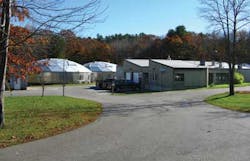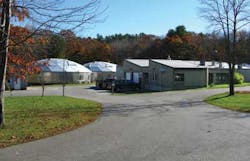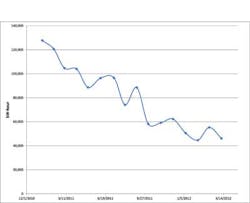Brian Cataldo, Leland Arris and Thomas Schwartz
When the Clean Water Act was enacted in the early 1970s, forcing many communities to build wastewater treatment plants, energy prices were relatively cheap so the facilities were often built without a great deal of attention to efficiency or power consumption. Times have certainly changed and plants that have not been upgraded are ripe for efficiency improvements. The Freeport, ME, Sewer District's plant fit that description until district officials realized that with new equipment and operations changes, they could save money and prevent a rate increase.
Teamed with the environmental consulting firm Woodard & Curran of Portland, ME, the district analyzed energy data from its plant using EPA's Portfolio Manager Software. The program reviews flow-normalized energy use and compares it to similar plants across the US. The software showed that the plant scored 2 on a scale of 100, indicating significant inefficiency. A baseline power assessment and energy audit were conducted to track down the sources of inefficiency.
The assessment showed that the four, 75-horsepower, single-speed air compressors used for secondary aeration, aerobic sludge digestion, and sludge pumping were delivering very large volumes of compressed air for a plant of this size (0.25 mgd). More importantly, the operators were dealing with weekly failures that were costing time and money.
The excessive amounts of compressed air — and therefore power — were largely required to move sludge with air lift pumping. In addition, a lack of control equipment prevented air output from being matched to biological demand. The evaluation was conducted to estimate the potential overall power saving if the process was upgraded. Total energy savings were calculated to be 625,200 kW-hr per year, which would result in a 50% reduction in power.
The assessment found additional areas for improvement. The facility was using more than 7,000 gallons of No. 2 heating fuel annually, a relatively large amount for the small footprint. This heavy energy usage was not surprising given the plant's design, which required heating open areas of long-spanning wooden beam roofs with no ceiling insulation. On top of this, the oil boiler was aged and operating at low efficiency.
Focus on Efficiency
The plant was using more than the national average of electricity per gallon of treated wastewater, and more than 80 percent of that power was used by the aeration blowers. There was significant potential to reduce the facility's energy consumption through more modern and efficient systems. Woodard & Curran designed a series of upgrades to correct these inefficiencies. This was accomplished through the addition of the following equipment and process changes:
- Two variable speed aeration blowers and VFDs;
- Dissolved oxygen sensing;
- High-efficiency fine bubble aeration diffusers;
- Three variable speed electric return sludge pumps and VFDs;
- Three constant speed electric sludge holding decant pumps;
- Two variable speed sludge holding tank blowers and VFDs;
- Sludge holding tank level sensing;
- Modifying plant aeration control programming at its existing SCADA system;
- Modifying sludge pump control programming at the existing SCADA system;
- Modifying level sludge mixing control programming at the existing SCADA system.
Multi-stage centrifugal blowers were replaced with Delta Hybrid low-pressure screw compressors by Aerzen. The low-pressure screw compressor technology is relatively new to the US wastewater marketplace, and the district provided one of two proving grounds for the manufacturer. The appropriate blower sizing and technology are essential to minimize energy consumption. The selected technology adapts a traditional screw compressor rotor for the low pressure requirements of aeration systems without wasting power due to over compression. Compressing air inside the air-end is more efficient than simple conveyance, and this coupled with turndown capabilities resulted in energy savings.
To address the inefficient and near-failing oil boiler, the district asked Woodard & Curran to conduct an alternatives analysis. The results compared the economics of various available fuels, equipment efficiency, and equipment lifecycle costs. The district was interested in effluent thermal heat recovery because it is highly efficient, has low annual operating costs, and a successful track record at area wastewater plants.
Clearly, there were several opportunities for improvement. The biggest challenge was how to pay for them, given the district's limited budget and other competing priorities. The next task was to secure funding.
Project Funding
The most promising funding source was Efficiency Maine. Efficiency Maine is a program that, as noted on its website, acts as "an independent trust dedicated to promoting the efficient and cost-effective use of energy in order to save money for Maine residents and businesses, grow the economy, and create jobs." Additional sources included the Community Development Block Grant (CDBG) program, the State wastewater Revolving Loan Fund (SRF) and American Recovery and Reinvestment Act (ARRA) funding. All sources were investigated. Freeport's median household income was too high to qualify for a CDBG grant and ARRA funds had already been allocated for the year, so the focus was on Efficiency Maine and SRF funding.
The district's Efficiency Maine and SRF applications were successful and funding was awarded for process upgrades, building envelope improvements, and energy recovery ventilation equipment for the sludge dewatering room. Construction costs were estimated at more than $1.1 million. The district was approved for a total of $290,000 in grant funding from Efficiency Maine toward those costs.
As the improvements neared implementation, Efficiency Maine relayed the news that its grants would be decreased the following year. This meant that the upgrades needed to be fast tracked or the district would receive nearly $190,000 less grant funding. This necessitated a design-build approach, an untested approach for the Maine SRF Program up until this project.
Freeport entered into an agreement to test Maine SRF program with the first design/build SRF contract award in the state. The project was advertised for competitive design/build bid solicitations and Evergreen Geothermal of Falmouth, ME, was selected to team with the district and install a heating system before cold weather moved in. At the same time that the bidding process was taking place, building envelope upgrades were completed so heating equipment could be properly sized.
This fast-track effort resulted in the immediate award of $260,000 from Efficiency Maine with the remaining $30,000 allocated when the sludge dewatering room upgrade work was completed. Maine's SRF program kicked in an additional $33,000 of principal forgiveness (grant) when the district agreed to incorporate sustainable asset management planning into the project. The rest of the funding came from the SRF program. By the end of November 2011, the system was commissioned and the district has not had heating fuel delivered since. As of mid-summer 2012, the district was on track to reach $80,000 in annual electricity savings.
Despite the project's overall $1.3-million price tag, users did not see an increase in their rates and will likely see a delay in the next rate increase because of the efficiency savings. Capturing grants and utilizing the SRF loan program to fund this project has resulted in positive return on investment starting day one. The successes of this project have been easy to document, from the decrease in the facility's monthly electric bill of $7,500, the elimination of the $24,000 per year heating oil bill, and its updated EPA Portfolio Manager score of 82. The Freeport Sewer District does not plan to stop here. It continues to look to the future with a review of pump stations and system-wide collections system rehabilitation.
About the Authors: Thomas Schwartz, PE, Vice President, Woodard & Curran, has 22 years of engineering experience in design, operations and maintenance, and capital improvements projects for municipal and industrial wastewater facilities. He may be contacted at [email protected]
Brian Cataldo, PE, Project Engineer, Woodard & Curran, has over 10 years of experience in operations, field engineering, energy assessment, and upgrade designs for municipal wastewater treatment facilities. He may be contacted at [email protected]
Leland Arris is General Manager of the Freeport Sewer District, a quasi-municipal corporation established in 1948 to provide and maintain a sewer system for the collection, treatment and disposal of sewage. He may be contacted at [email protected].




